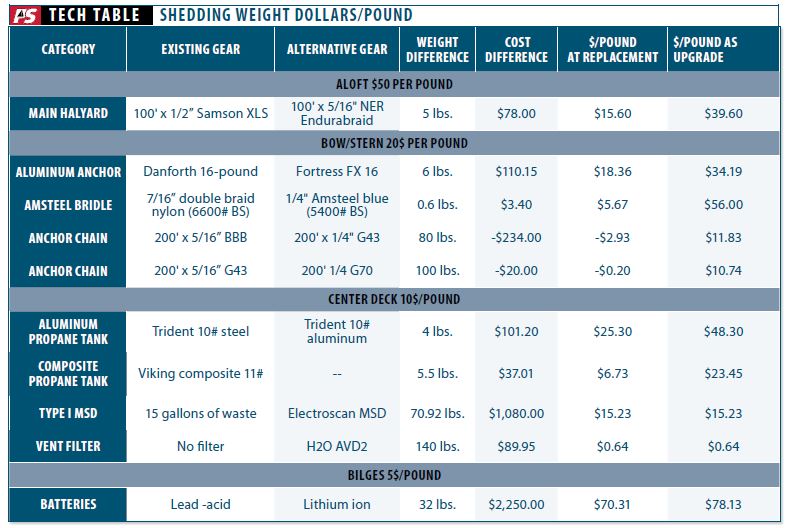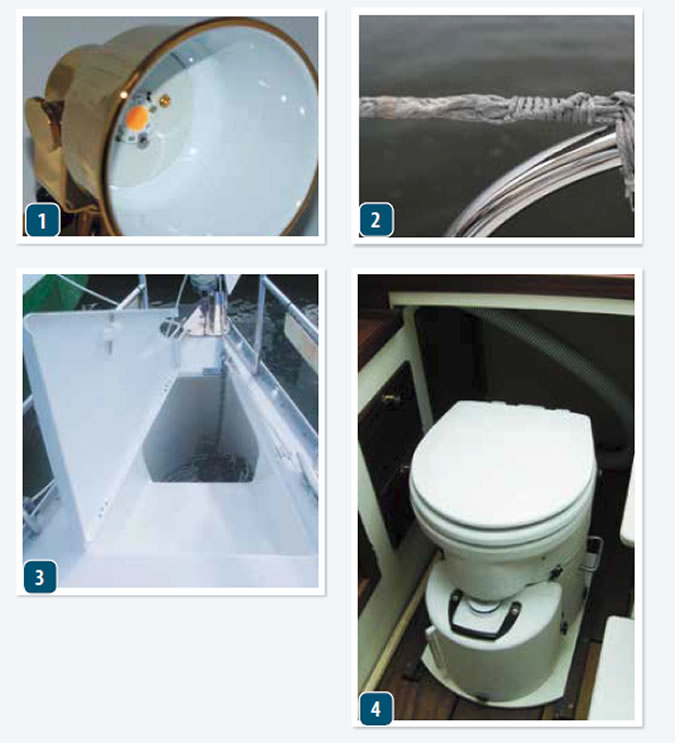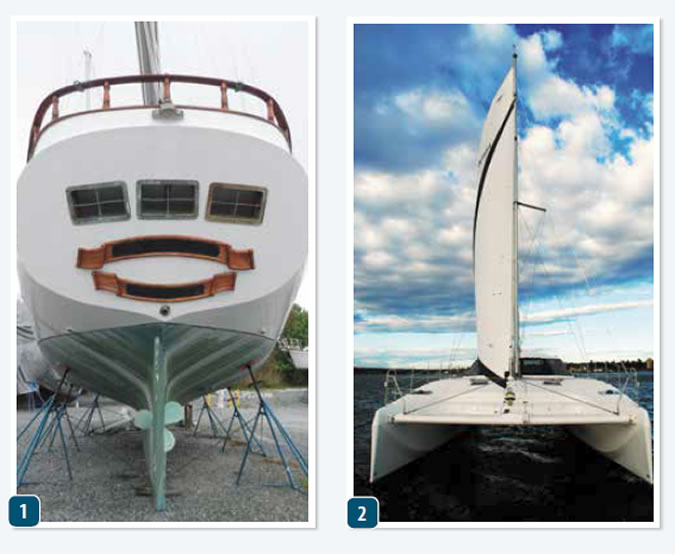Balsa and rigid foam cores. Aluminum, magnesium, and titanium alloys. Epoxy resins. Unidirectional glass, carbon fiber , and Kevlar. Builders have the most fantastic tools at their disposal to build light, durable boats … and then we weigh them down with all manner of stuff.
So what does a wasted pound cost you? Not all weight is equal. A pound at the masthead is more hurtful than a pound on top of the keel, and the exact values depend on the design. A light sport boat will heel noticeably more with even a few dozen pounds aloft, while a similar size catamaran would feel only a sharper motion. That same catamaran will pitch more noticeably with a person standing at the bow. For the sake of this exercise, weve established the following values for our test boats. Sure, they are arbitrary, but point is to have a rational scale upon which to base decisions.
Relative Value of a Pound Saved
Aloft $50
Extreme bow or stern $20
Center of boat $10
Bilge $5
Mast and Rigging. $50/pound.
Sails, standing rigging, and lazy jacks are all possibilities when replacement time rolls around. Certainly an aluminum mast is lighter than wood. Carbon fiber masts are still priced in the racers realm.
High Modulus Halyards. Polyester halyards are sized for stretch rather than strength. The ultra-low stretch characteristics of Dyneema, allow for aggressive down-sizing, saving considerable weight and windage aloft, where it matters most. You might gain speed due to improved sail trim (less sag and need to re-tension when the wind pipes-up). The problem for the cruiser is that going down by more than one size often means the clutches are the wrong size, taking us outside of the simple project restriction. Look at your equipment and evaluate your possibilities. For one of our test boats, changing 100 feet of line from -inch polyester double braid to 3/8-inch Dyneema core (equal strength) saves 2.5 pounds aloft and 2.5 pounds on deck at a cost difference of $150, or $30/pound average.
Bottom line: Recommended if you watch your sail trim or for a replacement.
Bow and Stern. $20/pound.
Too much weight in the bow and stern is a common problem on cruising boats. The penalty can be extremely sharp for boats with fine bows or some double-enders which can hobby horse if overloaded on the ends.
Nylon rode. While we like all-chain rodes for cruisers, there is no reason to carry more chain than you will need 95 percent of the time. On those rare occasions when more is needed, a short tail of nylon will not reach the bottom and will not be subject to chafe. You can save 30 pounds per hundred feet ($60 value) and $250 in chain cost by carrying only what you actually use.
Bottom line: Buy what you need, but don’t go crazy
High strength chain. If we compare roughly equal strength (1,900 pounds SWL for 5/16-inch BBB, 2,600 Pounds SWL for -inch G43), the cost savings for 200 feet is $240 and the weight savings is 150 pounds ($300 value). You may need a different windlass gypsy, although most of the windlasses sold in the US now come with G43/G70 compatible windlasses. What about G70 chain? Problems finding compatible connectors make this challenging.
Bottom line: Consider high strength chain when replacing, but be sure shackles match the chain (see PS October 2016).
Amsteel bridle. Many light trimarans use a nylon rode to save weight but still need a long bridle to keep the nose into the wind. They don’t need the snubber stretch and Amsteel can save a few pounds where it counts. Its easier to splice than three-strand, much easier than double braid.
Bottom Line: Consider high strength ropes where they make sense. Every boat has unique opportunities.
Anchors. Holding test results-both formal testing and field reports-on aluminum primary anchors are mixed. In harder bottoms, it seems, there is no substitute for concentrated mass to start penetration. On the other hand, the Fortress anchor has proven itself time and again as the most tenacious in sand and mud, consistently putting up impressive numbers before even considering lighter weight. Other aluminum anchors-Spade and Excel-can be very impressive in sand and mud bottoms. A $239 Fortress F-16 compares with a Danforth 16 for $89, but if you price weight in the bow at $20 per pound, as we have-the 6-pound savings is attractive.
Bottom line: While the primary should probably be a steel anchor of modern design and sized for moderate storms over good bottoms, an aluminum anchor makes a lot of sense as a secondary.
Dingy on davits. Piling weight high on the stern of a boat is one of our pet peeves, but for the coastal cruiser having the dinghy handy can be priceless for many. But you still trim down. Do you need 15 hp. with an external tank, or is 3.5 hp with an internal tank enough? If you want to go superlight, a carbon fiber Wing Dinghy is an option-at a very high price. Kayaks also serve some coastal cruisers well.
Bottom Line: We Recommend you consider your options based on how you use the boat. Less can be more.
In the Center. $10/pound.
Weve always felt that every locker should be emptied clear to the floor at least once each year. Youll find things that were lost or forgotten. And youll find junk:
Blocks and hardware. While there are many differences in durability and ease of use, we couldnt find any blocks that made any sense in terms of weight savings/dollar. There are exceptions. A lighter clew block on a jib can help the sail set better in light air.
Soft shackles lighten the sail clew and reduce the risk of damage to the mast or your head. But for cruising boat, the weight of traveler cars, winches, and genoa lead blocks if pretty unimportant.
Bottom line: Chose hardware based on function, not weight savings.
Spare ropes. A spare rode for kedging or towing and a few extra dock and spring lines are always prudent. Coastal sailors, going no more than a few hundred miles between stops, can usually get to the next port with temporary substitutions. New polyester rope is worth only $18/pound; old scraps are just not worth the $10/pound penalty. A few coils of smaller stuff for lashings and securing gear make sense.
Bottom line: The extras and retired stuff should be donated, coiled in the garage, or woven into mats and given to friends.
Lifelines. Stainless is about three times heavier than high-modulus fiber (Amsteel), and the cost penalty is close to $0 if the Amsteel is replaced at a conservative interval of 5-8 years. This assumes 20 to 25 year lifespan for stainless steel lifelines, but many variables can influence lifespan (see Long-term Test Evaluates Fiber Lifelines, September 2012). Chafe and UV should be carefully considered and the life will be less than bare stainless steel wire. Amsteel is not approved for off-shore racing at his time.
Bottom line: Good arguments can be made either way.
Bilges and deep lockers $5/pound
If youre going to carry extra weight this is where it belongs. A displacement cruising boat, especially can see little performance penalty with modest additions here.
Gasoline vent filter. Carrying around a full fuel tank to prevent evaporation and e-10 phase separation? Instead, consider a silica gel filter, which provides better storage stability, reduces evaporation loses in gasoline tanks (that will pay for it), keeps the water out, and is self-regenerating for at least 10 years.
Bottom line: We recommend carrying 8 ounces to save 100 pounds!
Diesel Vent filters. An 8-ounce vent filter eliminates the need to keep a full tank to reduce breathing, perhaps reducing by 100-150 pounds the amount of fuel that must be carried day sailing and on short trips.
Bottom Line: Only about $1/pound. A bargain.
Batteries. Lithium ion batteries can save nearly half the weight, offering advantages in charging time and cycle life as well, but at serious cost. Expect to pay at least five times as much as lead-acid batteries, for a weight saving valuation of >$50/pound. A much better way to save battery weight is to reduce consumption.
Bottom line: Extreme performance boats only.
Type I MSD. A Raritan Lectrasan might make sense for some folks-it weighs about the same as 10 gallons of water when full-but that is about what we average in our holding tank is full. In addition, Type Is arent permitted in our home port because it is a no discharge zone. Many cruisers have switched to a composting head, which also can offer weight savings, but will usually require some boat modifications.
Bottom line: Good for larger boats.
Freshwater tank. Theres really no reason for it to be full all of the time. A watermaker can make sense for the long term cruisers, though for long passages a full tank is insurance against mechanical failure. Rainwater collection should limit the requirement to carry jerry jugs.
Bottom line: To be safe on long passages, count on carrying about two gallons per person per day. Substitute sponge baths for showers on passage.
LED Lights. How much could a light bulb possibly save? Considering a 100 watts of incandescent cabin lighting used for just 5 hours consumes 40 amp-hours each day-about all that should be pulled from a group 27 battery before charging-a few bulbs can save 70 pounds or a $700 value. Alternatively LEDs might reduce the number of solar panels or eliminate need for a generator.
Bottom line: We Recommend LED for lights in regular use.
Leaks. Are the collision tanks in your catamaran bow holding water? A hundred pounds of water would create a $500-$2,000 loss in value, depending on whether the water is in a bow crash tank or the bilge. One more reason to fix those leaks.
Bottom line: Dry bilges are always Recommended.
Manuals and books. E-readers save space. However, there is a case for having essential documents and charts on paper as backup. As for books in general, e-readers are both economical and compact, if you can overlook the comfort of turning pages.
Bottom line: Scanning is only time, space is saved, and searchability is improved. Recommended if you like fooling with computers.
Charts. Most sailors have gone electronic, but most still carry basic paper charts in case of failure and because they have some advantages for planning and note-keeping. Just pare down. And plotting tools can be reduced to a bare minimum of plastic rules. While youre at it, consider dual-purposing the nav station for other uses such as a workbench.
Bottom Line: The modern chart table must be multi-faceted.
Spare and alternate sails. Should I have deep reef in the main or carry a tri-sail? Many sailors are going the deep reef route, saving a whole sail, though there are tradeoffs and the main will be heavier cloth.
Bottom line: Reducing sail inventory through use of roller furling sails is a helpful-but a storm inventory is essential for ocean voyaging.
Propane tanks. For a 10-pound propane tanks the weight savings is about 4 pounds and the cost differential is $110, or $25/pound. However, the aluminum tanks will not corrode, greatly increasing life and eliminated the annual clean/sand-re-paint ritual. Composite tanks are another option, both cheaper and lighter, giving a $5/pound cost at replacement time. However, they must be stored out of the sun in a propane locker to avoid UV damage.
Bottom Line: Aluminum tanks are great for reduced maintenance, not for weight savings.
Conclusions
Were not suggesting you go out and make big changes, only that each time you consider an upgrade, repair, or replacement you should consider the weight cost of the alternatives. Fight the inner packrat; we all have one, its human nature.
Speed doesn’t matter to you? Even so, an overweight boat does not handle her best either, around the marina or in rough weather. And for every pound you save, thats another pint of your favorite brew or a favorite book you can bring without guilt. How far you take all of this depends on your priorities. Think of it as a maintenance diet for your sailing life.


Clearly the heaviest items on board deserve consideration when you are trying to reduce weight, but sometimes the weight savings associated with a small changes can be significant. A pack-rat approach might serve in far-flung ports, but most cruisers can benefit from an annual purge.
- A lightbulb might not seem to represent a great deal of weight savings, but if you consider the extra battery weight that you can save by reducing energy consumption, small changes can result in significant weight savings.
- Switching from stainless steel lifelines to fiber lifelines represents another small savings in weight. Watch for chafe. Stainless is about three times heavier than Amsteel.
- Going on a diet should begin in the bow. Leave that extra space for lightweight bulky items like fenders.
- A composting head can eliminate a lot of extra weight if youre attracted to onboard treating.

Not all weight is equal. A pound at the masthead is more hurtful than a pound on top of the keel, and the exact values depend on the design.
- A broad beamed heavy displacement boat like this Bill Garden design will have a higher tolerance for weight aft than a double-ender.
- Fine boys on this Seawind catamaran reduces the amount of payload in the bow without impacting performance.

































